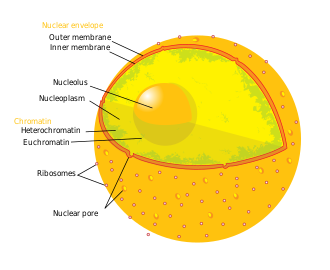Nuclear pore complex
(Redirected from Nuclear pore)
The nuclear pore complex (NPC) is a large protein complex that spans the nuclear envelope, which is the double membrane surrounding the cell nucleus. It regulates the transport of molecules between the nucleus and the cytoplasm, playing a crucial role in maintaining cellular function.
Structure
The nuclear pore complex is composed of multiple copies of approximately 30 different proteins known as nucleoporins. These nucleoporins assemble into a structure with an eightfold rotational symmetry, forming a central channel that allows the passage of ions, small molecules, and macromolecules.
The NPC is organized into three main regions:
- Cytoplasmic Ring: Located on the cytoplasmic side of the nuclear envelope, this ring is involved in the initial recognition and binding of transport substrates.
- Central Transport Channel: This is the core of the NPC, where selective transport occurs. It is lined with phenylalanine-glycine (FG) repeat domains that facilitate the movement of transport receptors and their cargo.
- Nuclear Ring: Situated on the nuclear side, this ring anchors the NPC to the nuclear envelope and interacts with the nuclear lamina.
Function
The primary function of the nuclear pore complex is to regulate the bidirectional transport of molecules across the nuclear envelope. This includes the import of proteins, such as transcription factors and histones, and the export of RNA molecules and ribosomal subunits.
Transport through the NPC is mediated by transport receptors known as karyopherins, which include importins and exportins. These receptors recognize nuclear localization signals (NLS) or nuclear export signals (NES) on their cargo molecules, facilitating their passage through the NPC.
Transport Mechanism
The transport mechanism involves several steps:
1. Recognition: Cargo molecules with NLS or NES are recognized by importins or exportins, respectively. 2. Translocation: The receptor-cargo complex translocates through the NPC via interactions with FG-repeat domains. 3. Release: Once inside the nucleus or cytoplasm, the cargo is released, often facilitated by the small GTPase Ran, which provides directionality to the transport process.
Role in Cellular Function
The NPC is essential for numerous cellular processes, including gene expression regulation, DNA replication, and cell cycle control. By controlling the flow of information between the nucleus and cytoplasm, the NPC ensures that the cell responds appropriately to internal and external signals.
Pathology
Dysfunction of the nuclear pore complex is associated with various diseases, including cancer, neurodegenerative diseases, and viral infections. Alterations in nucleoporin expression or mutations can disrupt normal NPC function, leading to impaired cellular homeostasis.
Advanced Imaging Techniques
Recent advances in imaging techniques, such as super-resolution microscopy, have provided detailed insights into the structure and dynamics of the NPC. These techniques allow for the visualization of individual nucleoporins and their interactions within the complex.
Related Pages
Transform your life with W8MD's budget GLP-1 injections from $125.
W8MD offers a medical weight loss program to lose weight in Philadelphia. Our physician-supervised medical weight loss provides:
- Most insurances accepted or discounted self-pay rates. We will obtain insurance prior authorizations if needed.
- Generic GLP1 weight loss injections from $125 for the starting dose.
- Also offer prescription weight loss medications including Phentermine, Qsymia, Diethylpropion, Contrave etc.
NYC weight loss doctor appointments
Start your NYC weight loss journey today at our NYC medical weight loss and Philadelphia medical weight loss clinics.
- Call 718-946-5500 to lose weight in NYC or for medical weight loss in Philadelphia 215-676-2334.
- Tags:NYC medical weight loss, Philadelphia lose weight Zepbound NYC, Budget GLP1 weight loss injections, Wegovy Philadelphia, Wegovy NYC, Philadelphia medical weight loss, Brookly weight loss and Wegovy NYC
|
WikiMD's Wellness Encyclopedia |
| Let Food Be Thy Medicine Medicine Thy Food - Hippocrates |
Medical Disclaimer: WikiMD is not a substitute for professional medical advice. The information on WikiMD is provided as an information resource only, may be incorrect, outdated or misleading, and is not to be used or relied on for any diagnostic or treatment purposes. Please consult your health care provider before making any healthcare decisions or for guidance about a specific medical condition. WikiMD expressly disclaims responsibility, and shall have no liability, for any damages, loss, injury, or liability whatsoever suffered as a result of your reliance on the information contained in this site. By visiting this site you agree to the foregoing terms and conditions, which may from time to time be changed or supplemented by WikiMD. If you do not agree to the foregoing terms and conditions, you should not enter or use this site. See full disclaimer.
Credits:Most images are courtesy of Wikimedia commons, and templates, categories Wikipedia, licensed under CC BY SA or similar.
Contributors: Prab R. Tumpati, MD





